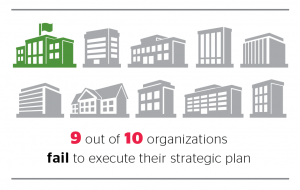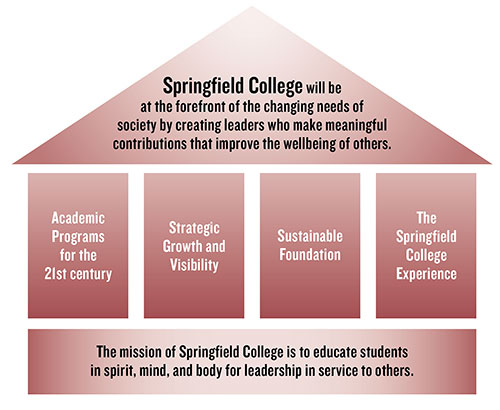Designing the Path Forward
Springfield College undertakes a living, action-oriented, vision for the future that belongs to the entire College community.
Springfield College undertakes a living, action-oriented, vision for the future that belongs to the entire College community.
Ask anyone what it means to be a Springfield College alumna or alumnus—a “triangle” to most—and you may get different examples, but they will all point back to the same truism: Springfield College alumni, students, faculty, and staff are leaders who provide service to society by rolling up their sleeves and doing the work that they see needs to be done.
This was true in 1885 when a group of leaders saw unmet need in their community and founded a college, when upperclassmen pulled rank over freshmen and demanded to build the College’s early roads, when faculty inventions and research helped the College garner international recognition, when a professor created Humanics in Action Day, and as recently as—well—now, when more than 250 members of the faculty, staff, and student bodies are involved in a strategic planning process that is steering their college in the best direction for the future.
“Early in my experience, I learned that Springfield College people are service-minded and action-oriented,” says President Mary-Beth Cooper. “We knew that, as we looked at emerging issues in society and in higher education and began to set our path for the future, College constituents would want to be engaged in the process, helping to make the decisions, doing the legwork, and combining their experiences and insights to ensure a strong future for the College.
“This involvement from all areas of the institution will result in a greater likelihood of success for us,” she remarks.
How did we get here?
When Cooper arrived in 2013, she listened and evaluated. In phase one of the process, faculty, staff, and students identified priorities and five emerged. They were enrollment, safety, diversity and inclusion, marketing and strategic communications, and increasing non-tuition revenue. These priorities, best categorized as alignment management, became guiding pillars for College work, and efforts were focused on these early in Cooper’s tenure.
Into her second year, and following numerous, in-depth conversations with the College’s Board of Trustees and campus leaders, she determined that the College mission and vision were strong; that data would be critical as strategies to move forward and address emerging issues were identified; and that the process should result in activity and the plan would not live on a shelf. Effective planning at this time was particularly critical since signs of a weakening industry beleaguered professionals in higher education, and there were higher-than-usual stakes.
Cooper looked for a model of an active, nimble, and dynamic approach to the strategic visioning process and found one that could hold great promise for the institution. In phase two, following the model, Cooper asked representatives from all constituencies to “Design the Path Forward” and help plan the future of the institution.
“I believed that engaging the whole College community at the ideas stage, asking them to help create efficiencies and become involved in intense planning could help us turn our great college into a thriving and excellent one,” remarks Cooper.
Interpreting the Data

There was copious College data to help understand its current state. From national assessment tools, prior planning documents, and the comprehensive strategic branding process, there was plenty of information to help identify the next series of strategic priorities and strategic positioning of Springfield College in the higher education marketplace. Lacking was information synthesis and a planning process that would be nimble enough to allow forward movement without encumbering trivial activity.
Determined not to be one of the nine of 10 organizations that are said to fail in executing their strategic plans, Cooper convened a “Design Team,” representing varied perspectives, experiences, and all constituent groups in spring 2015. The team met nine times in 2015 for more than 25 hours, and reviewed and synthesized more than 30 data sources consisting of more than 1,300 pages of data, reports, and analyses to identify the next set of strategic themes, and incorporate the existing five priorities from 2014.
Creating the Strategy
A set of themes emerged, and a strategy map was created. That map, outlining the College mission, vision, themes, objectives, and projects, was shared with the College community early in 2016, and open forums and identified group meetings were hosted to obtain input and feedback from faculty, staff, students, alumni, and parents, with a total of more than 300 people attending. The Board of Trustees then endorsed the strategic map.
The College vision to be at the forefront of the changing needs of society by creating leaders who make meaningful contributions that improve the wellbeing of others—determined through the recent strategic branding process—and its longstanding mission to educate students in spirit, mind, and body for leadership in service to others provide the umbrella and the foundation, respectively, for all initiatives and College work.
In phase three, strategic initiatives were developed from the analysis of data and input from all the campus constituencies. Identified themes of strategic growth and visibility, academic programs for the 21st century, the Springfield College environment, and sustainable foundation/responsible stewardship were crossed with stakeholders, financial and human resources, internal processes, and organizational capacity to determine how themes could be realized, what investments were necessary, what revenue might be realized, and what success would look like. And, a map for the working groups was born.
A successful strategy is an implemented strategy.
Faculty, staff, and students volunteered and were nominated for working groups for each objective and initiative, and senior leaders serve as liaisons for groups that fall within their division. The number of working groups, which totaled 17 at the beginning and climbed to 21 just before press time, will change as work is completed and new work is undertaken. To date, those involved in the process number approximately 250.

Springfield College’s strategic work has an action-oriented focus. It is practical, practicable, and iterative. Offerings, processes, and resources are being evaluated and changed as needed. “Most importantly, as this work moves from the working groups to implementation, the entire process will be assessed with key metrics,” says Mary Ann Coughlin, associate vice president of academic affairs, who has helped the President oversee the venture.
Two of the most exciting results to date have been the newly renovated Harold C. Smith Learning Commons, usage of which has increased exponentially, and the Center for Excellence in Teaching and Learning, which will provide the support that professors need to create the most engaging learning experiences for students.
Other key initiatives that are completed or currently underway include general education requirement review, a recruitment digital marketing plan, and a strategic plan for creating a more diverse and inclusive campus community, to mention a few.
“One of the most important things in process is the review of our academic programming as it relates to the changing needs of our students and our society,” says Provost and Vice President for Academic Affairs Martha Potvin. The Comprehensive Academic Program Review working group collected data and feedback on all concentrations and programs, and is developing recommendations that will be shared with the community during spring semester.
“We are looking at all of our programs to determine their sustainability as well as possible areas for expansion,” says Potvin. “All of this is done with an eye toward mission alignment, stakeholder feedback, and benchmarking. The data are helping to make our choices clear.”
Student engagement has been a driving force in the process, and two working groups have been committed to identifying and implementing learning opportunities that best engage our students. These include the creation of living-learning communities through which students with similar interests live together and participate in programs that center around their academic interests. Currently, two pilot living-learning communities—entrepreneurship (open to all majors) and life and health sciences (focus on biology, sports biology, pre-physician assistant, and pre-physical therapy majors)—are thriving in Massasoit Hall.
The Center for Excellence in Teaching and Learning has been created to support faculty teaching, scholarship, and service. The new center recently opened in the Harold C. Smith Learning Commons and provides pedagogical expertise, scholarship support, and space for faculty development and collaboration. A new director will join the center this spring.
The newly created Center for Leadership and Civic Engagement helps fulfill the College mission to serve, and provides educational and wellness resources for the greater Springfield community. The Center’s programming is determined by the issues that students, faculty, and staff believe they can positively influence and provides opportunities for them to grow as leaders in service to others.
And, the Web Development and Messaging Consistency group creates a targeted and personalized web experience that helps prospective students and families understand Springfield College values, offerings, and how they can benefit from a Springfield College education.
Additionally, key partnerships are being pursued with organizations that will further help us meet the needs of our students. Those organizations, among others, include the Canyon Ranch Institute, with whom the College has partnered to bring the Healthy Table program to our local community (see page 18), and the Cal Ripken, Sr. Foundation with whom the College built the Archie Allen Field, incorporating a collegiate baseball field, youth development park, and ability field, on the campus.
“This is a unique strategic planning process,” explains Coughlin. “It’s not your typical strategic planning process where we ‘write it and shelve it’. President Cooper has a model that allows us to develop an iterative process through which we address issues that move the College forward. Our plan is data-driven and action-oriented, evolves from the work that we are doing, and is flexible and adaptable. ”
“And, while the process has helped us plan,” says Coughlin, “it also has benefited individuals at all levels of the organization by providing training and presentation opportunities for students, faculty, and staff on the campus. Moreover, close work between groups provides an example of another benefit of this process: increased collaboration.”
The College vision, determined through our strategic branding process, is to be at the forefront of the changing needs of society by creating leaders who make meaningful contributions that improve the wellbeing of others.
“On our committee,” says Vice President and General Counsel Christopher Neronha, “we had a lot of individuals who hadn’t been involved in a College-wide group. One member, who was very valuable, said it helped her make connections to other people.
“She was able to share her own management strategies to the benefit of our group work. We might not have had her input in a different type of process,”
he says.
What’s to come?
Early in December 2017, Moody’s Investor Services revised its outlook for higher education in the United States for 2018, downgrading it from stable to negative. According to an official there, the rating reflects the anticipation that revenue at these institutions will “soften” and not keep pace with expenses in the coming year. The downgrade reflects concerns over affordability by prospective students and families, as well as demographics that show a diminishing number of high school students. While some colleges and universities are expected to close or consolidate, private institutions like Springfield College, with the right planning, could outpace public ones.
Its longstanding mission, lived through the Humanics philosophy, is to educate students in spirit, mind, and body for leadership in service to others.
The organizational health of Springfield College is very good, in spite of industry concerns. In fact, the College enrolled the largest class in its history—representing 22 percent growth—in fall 2017. According to Ruffalo Noel Levitz, the nation’s largest consulting firm for higher education enrollment management, a three- to five-percent enrollment increase in any given year is considered to be strong in today’s competitive market. “The Springfield College 22-percent growth goes significantly beyond that mark,” says Stuart Jones, vice president for enrollment management, “especially in light of declining high school enrollment in our region.”
“This demonstrates that the value proposition of a Springfield College education, grounded in the Humanics philosophy, remains highly regarded,” says Cooper.
This innovative and customized approach to strategic planning has allowed Springfield College to strategically and tactically plan for the future in real time, with enrollment, affordability, career relevance, new delivery mediums, and the value of a higher education degree at the core of our evaluation and desired outcomes, explains Cooper.
“It is an exciting and highly workable process that allows us to assess emerging issues as we undertake the future planning process,” says Cooper. “As a result, we have a strategic plan that is responsive to the nuances of the market and the changing needs of our students, faculty, and society.”
As Roger Martin published a few years back in the Harvard Business Review [Jan.-Feb. 2014], “Strategic planning forces us to confront a future about which we can only guess.” But, this is a process through which emerging issues can be addressed at the breakneck speed with which they appear, keeping Springfield College healthy, vital, and strong for future generations of students.




